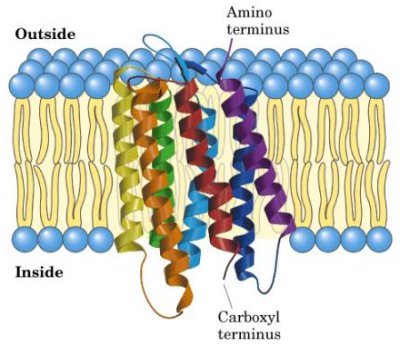bacteriorhodopsin

Bacteriorhodopsin is a light-activated protein found in the membranes of certain species of archaea, known as halobacteria, which inhabit extreme environments such as salt marshes and hot springs. It is the basis of a simple photosynthetic system which supplies these life-fors with chemical energy.. Interestingly, bacteriorhodopsin is chemically very similar to the light-sensitive pigment rhodopsin, found in the vertebrate retina.
Bacteriorhodopsin is a member of the opsin family of proteins, which also includes visual pigments found in the eyes of animals. However, unlike visual pigments, which are used for the purpose of vision, bacteriorhodopsin is used by bacteria as a means of generating energy. When light is absorbed by the protein, it undergoes a series of conformational changes that result in the release of a proton from the molecule. This proton is then able to flow across the bacterial membrane, creating a proton gradient that can be used to generate ATP, the primary source of energy for cells.
Bacteriorhodopsin has a number of unique features that make it well-suited for its role in energy production. For example, it is extremely stable and can function over a wide range of temperatures and pH levels, making it suitable for use in extreme environments. It is also highly efficient, with a quantum yield (the percentage of absorbed light energy that is converted into chemical energy) of up to 95%.
Despite its many beneficial properties, bacteriorhodopsin is not without its limitations. One of the main challenges associated with the protein is that it is sensitive to certain types of damage, such as oxidation or exposure to high temperatures. This can result in the loss of function or degradation of the protein, which can have negative consequences for the bacteria that depend on it.
Despite these challenges, bacteriorhodopsin remains an important subject of study for researchers in a variety of fields, including biochemistry, biophysics, and biotechnology. In recent years, it has been the focus of numerous research projects aimed at understanding its structure and function at the molecular level, as well as its potential applications in fields such as renewable energy and biosensing.
One area of particular interest is the use of bacteriorhodopsin in solar energy conversion. Researchers have explored the possibility of using the protein as a means of capturing and storing solar energy in the form of chemical energy, which could then be used to power various processes. While much work remains to be done in this area, the potential for using bacteriorhodopsin in renewable energy systems is significant, and could lead to the development of new and more efficient ways of harnessing solar energy.
Another area of research that has received considerable attention is the use of bacteriorhodopsin as a biosensor. Biosensors are devices that are capable of detecting and measuring the presence of specific molecules or compounds in a sample. By incorporating bacteriorhodopsin into biosensors, researchers have been able to create highly sensitive and selective devices that are able to detect trace amounts of a wide range of compounds, including toxins, pathogens, and other substances of interest.


